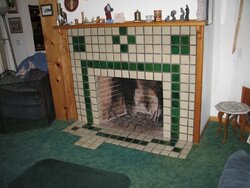Advice please regarding insulation requirements for a hearth extension.
Finally I have decided to put a wood-burning stove insert into our fireplace so that we can keep more of the heat from our fires. The problems is that our 15.5 inch tile hearth on a cement base in front of the fireplace is not enough for the requirements of the stove or our insurance. I have leftover matching tiles from the original construction and had planned on extending the tile another 8.5 inches. After two scary discussions with someone at Home Depot and a wood stove salesperson explaining the minimal R-factor with tile and wonderboard, and that if the insurance company decides that the R-factor was not good enough, they would refuse to pay for a house fire, I pretty much decided not to take on the project.
Then when I ordered our Lopi Freedom Bay insert yesterday the very experience salesperson said that all of those r-factors are not needed on the extension over 10 inches from the front of the glass. He said that all I needed was a non-burnable surface....i.e. that tile and wonderboard would be sufficient. He said that I could just buy a micor extension, cut it to size and put in under the tile if I wanted to be safe.
Why is a layer of micor extension considered sufficient when often in these discussions it sounds like I would need a couple of feet of insulation?
Where to find Micor....I am worried that if I go to a ceiling store, that I would get the wrong stuff and the insurance company would wash their hands of me.
Is there a formula for decreasing r-factor requirements the further from the stove that the flooring is located?
Thanks
Bob
Finally I have decided to put a wood-burning stove insert into our fireplace so that we can keep more of the heat from our fires. The problems is that our 15.5 inch tile hearth on a cement base in front of the fireplace is not enough for the requirements of the stove or our insurance. I have leftover matching tiles from the original construction and had planned on extending the tile another 8.5 inches. After two scary discussions with someone at Home Depot and a wood stove salesperson explaining the minimal R-factor with tile and wonderboard, and that if the insurance company decides that the R-factor was not good enough, they would refuse to pay for a house fire, I pretty much decided not to take on the project.
Then when I ordered our Lopi Freedom Bay insert yesterday the very experience salesperson said that all of those r-factors are not needed on the extension over 10 inches from the front of the glass. He said that all I needed was a non-burnable surface....i.e. that tile and wonderboard would be sufficient. He said that I could just buy a micor extension, cut it to size and put in under the tile if I wanted to be safe.
Why is a layer of micor extension considered sufficient when often in these discussions it sounds like I would need a couple of feet of insulation?
Where to find Micor....I am worried that if I go to a ceiling store, that I would get the wrong stuff and the insurance company would wash their hands of me.
Is there a formula for decreasing r-factor requirements the further from the stove that the flooring is located?
Thanks
Bob


 I have leftover matching tiles from the original construction and had planned on extending the tile another 8.5 inches. After two scary discussions with someone at Home Depot and a wood stove salesperson explaining the minimal R-factor with tile and wonderboard, and that if the insurance company decides that the R-factor was not good enough, they would refuse to pay for a house fire, I pretty much decided not to take on the project.
I have leftover matching tiles from the original construction and had planned on extending the tile another 8.5 inches. After two scary discussions with someone at Home Depot and a wood stove salesperson explaining the minimal R-factor with tile and wonderboard, and that if the insurance company decides that the R-factor was not good enough, they would refuse to pay for a house fire, I pretty much decided not to take on the project.